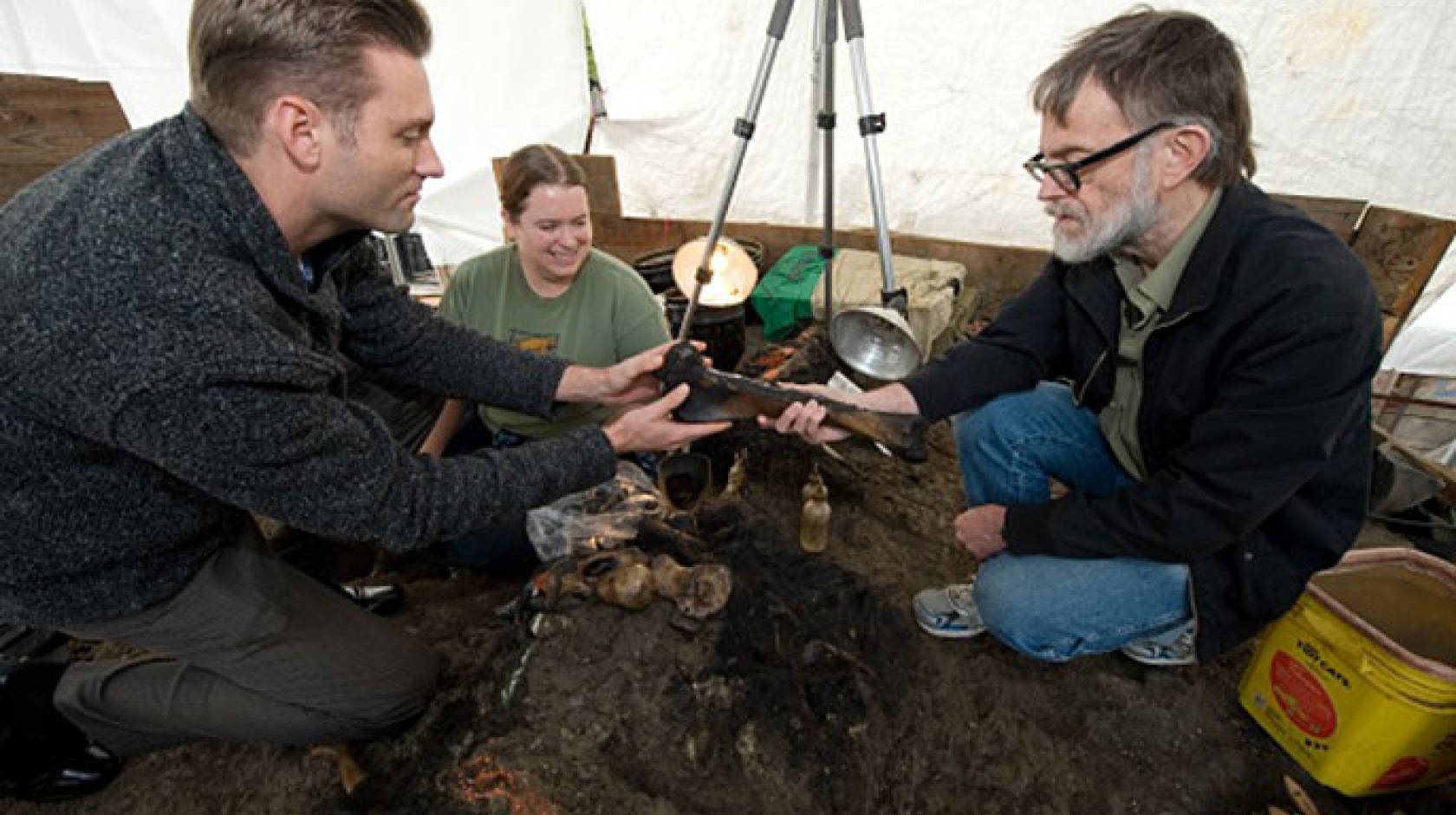Kathryn Bold, UC Irvine

Amid row after row of carefully cataloged bones warehoused in the La Brea Tar Pits’ George C. Page Museum, UC Irvine Earth system science researchers John Southon and Benjamin Fuller pore over a prehistoric puzzle piece: a 6-inch bit of skeleton from a dire wolf that roamed what is now the heart of Los Angeles during the last ice age.
Wielding a rotary tool, Southon saws off a tiny portion of the bone. “It smells like a dentist’s office,” Fuller observes. “That’s a great sign. It means there’s a lot of protein for us to test.” The pair will take the sample back to UC Irvine’s W.M. Keck Carbon Cycle Accelerator Mass Spectrometry Laboratory to find out its age using advanced methods they developed for radiocarbon dating.
Southon and Fuller have analyzed all kinds of fossils pulled from the bubbly asphalt, from 40,000-year-old flecks of wood to a giant teratorn — an extinct bird of prey with a 12-foot wingspan. They’ve tested a 41,000-year-old camel and a 35,000-year-old American lion, one of the largest cats ever to have existed.
“The reason the tar pits are so interesting is that they’re a record that preserves the entire ecosystem,” Southon says. “There’s everything from twigs and seeds to mammoths. They potentially can tell us how the system evolved.”
Zeroing in on a date
In 2011, he got a call from John Harris, the Page Museum’s chief curator, asking for help in carbon-dating fossils recovered from a nearby construction site (now an underground parking garage for the Los Angeles County Museum of Art).
“They wanted a feel for how old some of them were,” Southon says. The finds are embedded in deposits of earth that the museum stores in 23 giant wooden boxes. Excavators using dental instruments have painstakingly uncovered an array of well-preserved fossils, including gophers, snails, fish, millipedes, bison and a Columbian mammoth they nicknamed Zed. (Southon determined that Zed is about 37,000 years old by testing a piece of his second thoracic vertebra.)
“The problem with La Brea is that it’s all jumbled. If you take a sample of ocean sediment or soil, the stuff on the bottom is older than what’s on top,” he says. “Here, the fossils are churning around in the tar like a washing machine. You can have 11,000-year-old bones right next to ones that are 30,000 years old. That’s exactly what we’ve found.”
Museum curators, archaeologists and other Indiana Jones types weren’t always too keen on subjecting their irreplaceable collections to radiocarbon dating because the older methods involved taking large samples of the items.
Preserving specimens
Scientists have been carbon-dating bones from La Brea since the 1960s, Southon notes. He had to show the curators that the advanced techniques used at UC Irvine requires samples just 0.01 the size previously needed, so there’s minimal damage to the fossils.
“They’ve got one long limb bone of an American mastodon on display with a great big chunk out of it [from a 1969 test],” he says. “Museum curators don’t like that. We deal in milligrams rather than grams.”
Once La Brea officials were assured that the newer dating methods resulted in no serious bone loss, treasures began to flow into UC Irvine’s accelerator mass spectrometry lab.
So far, Southon and Fuller have dated about 100 specimens, a tiny fraction of the more than 3 million fossils stored at the Page Museum, with more being unearthed nearly every day. “It’ll keep us busy a long time. It’s just lucky UC Irvine is so close to the tar pits,” says Fuller, who makes the trip with Southon about once a month.
Working on the blackened bones, lab members solved another key problem, one that any person who has ever walked barefoot on an oily beach can appreciate: getting the tar out of the samples.
“It’s heavy oil, and these things have been sitting there for 10,000, 20,000 or 50,000 years. The tar has completely impregnated the bones,” Southon says. “The techniques [for cleaning samples] were time-consuming and laborious. We found an easier way.”
He and Fuller devised a chemical process whereby larger petroleum molecules are separated from the specimens.
“We start out with black gunge, put it through ultrafilters, and what comes out is this beautiful white collagen,” Southon says. Removing the carbon contaminants allows researchers to get more accurate ages on the samples.
Cats, leaves, bugs — oh my
With the new techniques, the two men can date 20 to 30 animals in a couple weeks. In addition to saber-toothed cats and other larger fossils, they carbon-date leaves, twigs and even tiny insects. Such time stamps can yield valuable information about the prehistoric habitat, causes of extinction and climate patterns.
“There’s a whole world of untapped treasures we can study with the help of UC Irvine’s [AMS] lab,” says Anna Holden, project manager in the entomology department at the Natural History Museum of Los Angeles County and a curatorial assistant with the Page Museum.
She, for instance, has been studying ice-age insects — including ladybug, weevil and beetle fragments — that were found sealed inside the skull of a camel that the lab estimated to be 41,000 years old. Entomologists know what the insects eat and what kind of weather conditions they tolerate, so dating them offers important clues about the time in which they lived.
“UC Irvine raises the value and significance of this research,” Holden says. “John and Benjamin have revolutionized the work we do here.”

